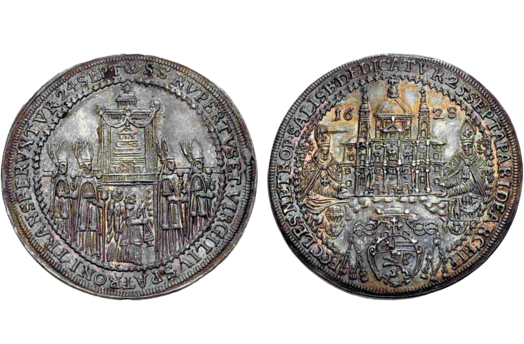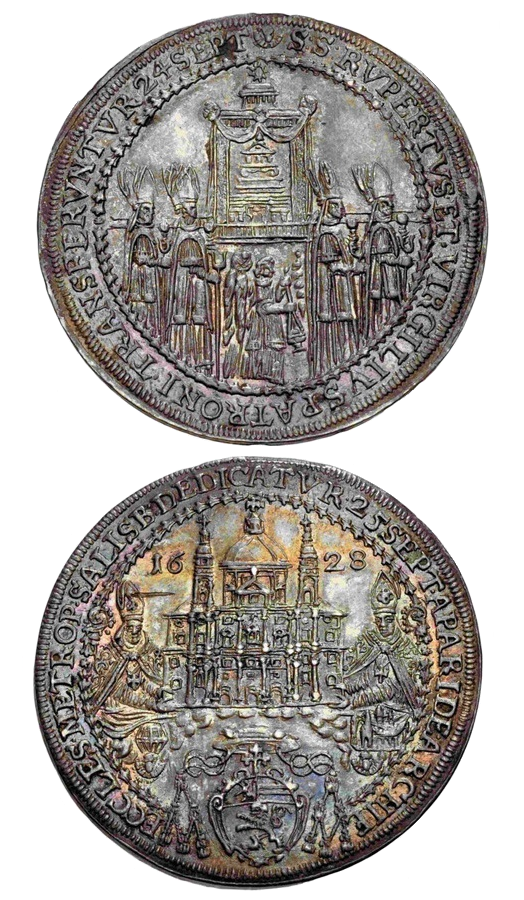
about ancient nomos
Ancient Nomos Art is a museum of galleries exhibiting ancient coins and ancient mint maps. The coin gallery displays the diverse art and history of hand-crafted ancient Greek, Roman, Byzantine, Persian and Medieval coinage. The ancient mints mapping gallery features Greek, Roman, Byzantine, Asia Minor and Medieval mint city regions and territories. Visitor's are welcome to explore, study and enjoy Ancient Nomos Art.

Post-Medieval Austria – 1628 AD
Paris von Lodron
From Ancient Galleries

Obverse: Reliquary procession of the relics of Saints Rupert and Virgil in a domed shrine carried by eight Bishops.
Reverse: Monastery Saints Rudbertus and Virgilius enthroned on clouds and each holding the Salzburg Cathedral.
ENLARGEMENTS

LEGENDS
Dedication Commemorative of the Salzburg Cathedral (Salzburger Dom) Consecration
Mint issued dates: 24-25 September 1628 AD
Archbishop: Paris Graf von Lodron
Obv: SS: RVPERTVS • ET. VIRGILIVS • PATRONI • TRANSFERNVNTVR • 24 SEPT (winged angel’s head), Reliquary procession of the relics of Saints Rupert and Virgil in a domed shrine carried by eight Bishops walking right (one Bishop facing), below two angels with censer, around wreath of leaves with incense rising. Rev: ECCLES: METROP • SALISB: DEDICATVR • 25 SEPT • APARID • ARCHIE. The two monastery saints Saints Rudbertus and Virgilius with their attributes are enthroned on clouds opposite each other, their heads turned to the front, and holding the Salzburg Cathedral, on the sides the divided year 16 – 28, including a three-field, combined monastery and family coat of arms above Cardinal hat with hanging tasseled gallero, wreath of leaves all around Baroque style architecture.
This exquisite Salzburg Cathedral commemorative coin was issued to mark the grand opening of the new building in 1628 AD. The very elaborate engraving features a highly detailed depiction of medieval mythology, procession and the artful display of religious celebration by procession. It also underscores the importance of church power structures, juxtaposed in a contemporary time and space paradigm of Renaissance thought, design and philosophy. The 1628 Salzburg commemorative coinage epitomizes the bold continuation of the Middle-Age presence in daily life, a deep seated archetypical mythos and primal mindset that extended well into post-medieval Europe; over one hundred years after the beginning of the Renaissance in Florence, Italy. This is a complex multifaceted coin, issued by Paris Graf von Lodron as a commemorative half-taler, celebrated his newly redesigned Salzburg Cathedral, in the “modern” Italian Baroque style of the day. The piece exemplifies how the persistence of medieval myth, thought and mindset, dominated by the Catholic Church and its powerful institutions, continued to influence the belief system of its citizens and ruling monarchs. The medieval ecclesiastical structures, i.e. architecture, sanctuaries, relics, token symbols, figures, etc., depended upon perpetuating a vividly clear figurative representation of religious belief, coinciding with its elaborate ceremony well into the Renaissance and Enlightenment eras. In fact, the medieval belief in the power of relics, the physical remains of animal, plant or person, or even inanimate object types like stone and shells, is known to have occurred in the earliest of sacred spaces in the ancient Neolithic human habitats of Asia Minor. The beautifully executed scene displayed above is one of Saints, buildings and deity worship as the intermediary sources through which a powerful mythos of relic objects is both a path to redemption, as well as providing a spiritual link between life and death. The sacred use of relics continued well into the Renaissance, where many religious building alters had ownership of one type of relic or other was a competitive endeavor for artifacts and honored privilege of cathedral possession. The above silver halbtaler (half-taler) illustrates how a juxtaposed post-medieval cathedral image remained an integral part of historical religious ceremony and church propaganda, well into the 17th century AD. The 1628 AD completion of the Salzburg cathedral and consecration of the building was a grand eight-day baroque style festival in Austria. The original Gothic cathedral burned down in 1598 AD, under Archbishop Wolf Dietrich von Raitenau. His successor Markus Sittikus von Hohenems (1612-1619) began a new building in the Baroque style. Its builder was the Italian architect Santino Solari, who continued construction under his successor Paris von Lodron. The cathedral was consecrated on September 24-25, 1628 AD, as noted in the legends on both the obverse and reverse sides of the coin.
DOCUMENTATION
Value: Commemorative Halbtaler (half taler). Metal: AR Silver. Weight: 14.39 grams. Mint: Salzburg, Austria. Date: Struck 24-25 September 1628 AD.
Attribution: Probszt 1167; KM 141; Fb. 729; Zöttl 1251. Photo courtesy CNG, LLC.
Legend, Documentation and Attribution
